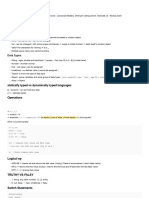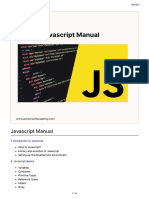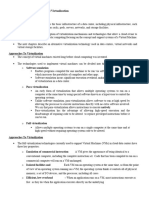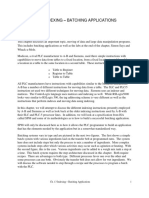Java Script
Uploaded by
Tanish SoniJava Script
Uploaded by
Tanish SoniJava script
1. Conditional statement :- if else, switch case
2. Looping :- for loop, break, continue, nested for loop, while and do while loop
Do practice pattern questions , foreach loop =>
this loop gives values of array one by one by storing in a callback function ,more at 5.7
3. Array = Linear data structure, colletion of similar data types.
Multidimensional array = Array under array let ar = [1,24,5,[3,4,6]];
4. Loop in array :- For of loop => to print index value of the array
For in loop => to print index address of the array
4.1 Array methods :-
a. push() => adds new value in array in the last.
syntax => arr.push(value)
b. unshift() => adds new element in the start.
syntax => arr.unshift(value)
c. pop() => To remove any element from the array at end, if it is printed then it give the
removed value
syntax => arr.pop(), console.log(arr.pop())
d. shift() => To remove any element from the array at start, if it is printed then it give the
removed value
syntax => arr.shift(), console.log(arr.shift())
e. tostring() => It returns string elements from the array separated by the comma (,), used by
creating a new variable and calling it
syntax =>let x = arr.tostring()
console.log(arr.tostring())
f. join() => Works same as tostring, we can use separators by our choice
syntax => let x = arr.tojoin('|'), print the variable
here pipes are the saparators
g. includes => to check that the element is present or not in the array and give the answer in
boolean T or F
syntax => console.log(arr.includes(50))
h. concat() => To join the two arrays
syntax => let x = x.concat(y), it joins the x array from y.
i. splice => to remove element from more than one idx
splice() => arr.splice(idx, no of ele to remove, no to add new)
arr.splice(1,3,24)
j. arr[idx] =value, to update array idx
5 Function :-
5.1 Normal function =>
function name() {
// block of code
5.2 function with parameters
function name(a, b){
// block of code
here a and b are parameters for input data or other operations, we can use default parameters that
is (a, b=6), value for b is given if eternally any parameter is provided dis replaces this default
parameter
5.3 Return type function
function name() {
return // block of code
it means it does not print any value until is store at other var and call it
5.4 Arrow function
let name=(a,b) => //block of code;
Here the function is created by arrow(=>)
writng return is mandatory if curly braces {} are used
5.5 this keyword:- this keyword is represent different behaviour at different places
example :- when it is used in function
let obj = {
name : "tanish",
course : "b.tech",
cinfo:function () {
console.log(this.name)
obj.cinfo()
this => here it represent the object
this.name => here this keyword represents element
when it is used in arrow funciton
let obj = {
name : "tanish",
course : "b.tech",
cinfo:() => {
console.log(this)
obj.cinfo
here it represents window object
5.6 Callback function=>
when a function is called within a parameter then it is called callback function
let displayData=(res) => {
return res
let sumData=(num1, num2, result) => {
return result(num1+num2)
let outPut = sumData(10,50, displaydata)
console.log(outPut);
here the funntion displaydata is called in result parameter and the vlaue of result in sotred in the
displaydata function
5.7 foreach loop =>
this loop gives values of array one by one by storing in a callback function
example => let l= [3, 42, 54, 64, 63]
l.foreach((v.i) => {
console.log(v,i);
})
here the elements are stored in a anonymous function (functon which has no name), the
elements are stored in first paramenter and the index value in second
5.8 map() =>
This function creates new array using existing elements of previous array by performing any
operation, it creates array with same no of elements in the previous, if 5 ele in prevoius the new
will be 5
example => let arr = [10, 20, 34, 43, 53]
let finalans = arr.map((v,i) => v+5)
console.log(finalans)
output = [15,25,39,48,58]
The seprate callback fundtion wil be :-
let calculate = (v,i) => {
return v+5
let finalans=arr.map(calculate)
console.log(finalans)
5.9 filter() =>
This function does not creat another array but replace its elements for the given conditions or it
sorts the element for given filter , does not change the value of elements
example :- let arr = [11,22,33,55,66]
let arrfilt= arr.filter((v,i) => v%2==0)
console.log(arrfilt)
output => 22,66
5.10 reduce() =>
This function do some operations on array and give single element
example => let l = [10,20,30,40,50]
let final = l.reduce((total,v,i) => total+v)
console.log(final)
output => 150
here the parameter totoal stores the final answer, v stores the elemets for arr and i stores idx values.
In the final variable the sum of v and i stored in the totla paramenter and after completing the
function the value of total get printed.
6 Document Object Model (DOM) =>
This model represents the graph of the html elements
6.1 Calling elements by id =>
We can call elements by their id
Example =>
<h1 id="heading"> Welcome to CDGI <b>INDORE</b></h1>
let head = document.getElementById('heading')
console.log(head)
in head var h1 tag content is called by their id heading
console.log(head.innerText) :- for getting only inner txt
console.log(head.innerHTML) :- for getting inner text with innter html tags like indore under b tag
let para = document.getElementById('pg')
para.innerHTML=head.innerHTML; :- here the content of heading are stored in para tag
6.2 Using events =>
Events are things that happen in the system you are programming, which the system tells you about
so your code can react to them.
<input type="password" id="pass">
<button id="btn" onclick="showhidepass()">SHOW</button>
let password = document.getElementById('pass');
let button = document.getElementById('btn')
function showhidepass(){
if(btn.innerHTML=="show"){
password.type="text";
btn.innerHTML="hide";
} else {
password.type="password";
btn.innerHTML="show";
Here on clicking the password show and hide
6.3 Add Event Listener =>
You might also like
- Lecture-3 Loops, Arrays, Function and Object-3267 (1) - 3795No ratings yetLecture-3 Loops, Arrays, Function and Object-3267 (1) - 379515 pages
- 12 JavaScript Concepts That Will Level Up Your Development Skills - Hacker NoonNo ratings yet12 JavaScript Concepts That Will Level Up Your Development Skills - Hacker Noon33 pages
- Lecture-3 Loops, Arrays, Function and Object-3267No ratings yetLecture-3 Loops, Arrays, Function and Object-326716 pages
- Must To Know Array Methods in Javascript - DEV Community ? ?? ? PDFNo ratings yetMust To Know Array Methods in Javascript - DEV Community ? ?? ? PDF1 page
- C Functions (Call by Value N Call by Reference)No ratings yetC Functions (Call by Value N Call by Reference)20 pages
- Graph Theory and its Applications_ What Can Graphs Do for Your Software_ _ by Héla Ben Khalfallah _ Sep, 2024 _ ITNEXTNo ratings yetGraph Theory and its Applications_ What Can Graphs Do for Your Software_ _ by Héla Ben Khalfallah _ Sep, 2024 _ ITNEXT52 pages
- Top Perfmon Counters For Analyzing SQL Server Performance IssuesNo ratings yetTop Perfmon Counters For Analyzing SQL Server Performance Issues49 pages
- Is It Possible To Add New Lines To A Standard Purchase Order Via PdoiNo ratings yetIs It Possible To Add New Lines To A Standard Purchase Order Via Pdoi5 pages
- Azure DevOps (Contd) - Direct DevOps From Quality ThoughtNo ratings yetAzure DevOps (Contd) - Direct DevOps From Quality Thought2 pages
- Lecture 2 Fundamentals of Classes in JavaNo ratings yetLecture 2 Fundamentals of Classes in Java12 pages
- Synopsis On Operating System Simulator: Computer ScienceNo ratings yetSynopsis On Operating System Simulator: Computer Science6 pages
- A Study On The Use of IDE Features For DebuggingNo ratings yetA Study On The Use of IDE Features For Debugging4 pages
























































































